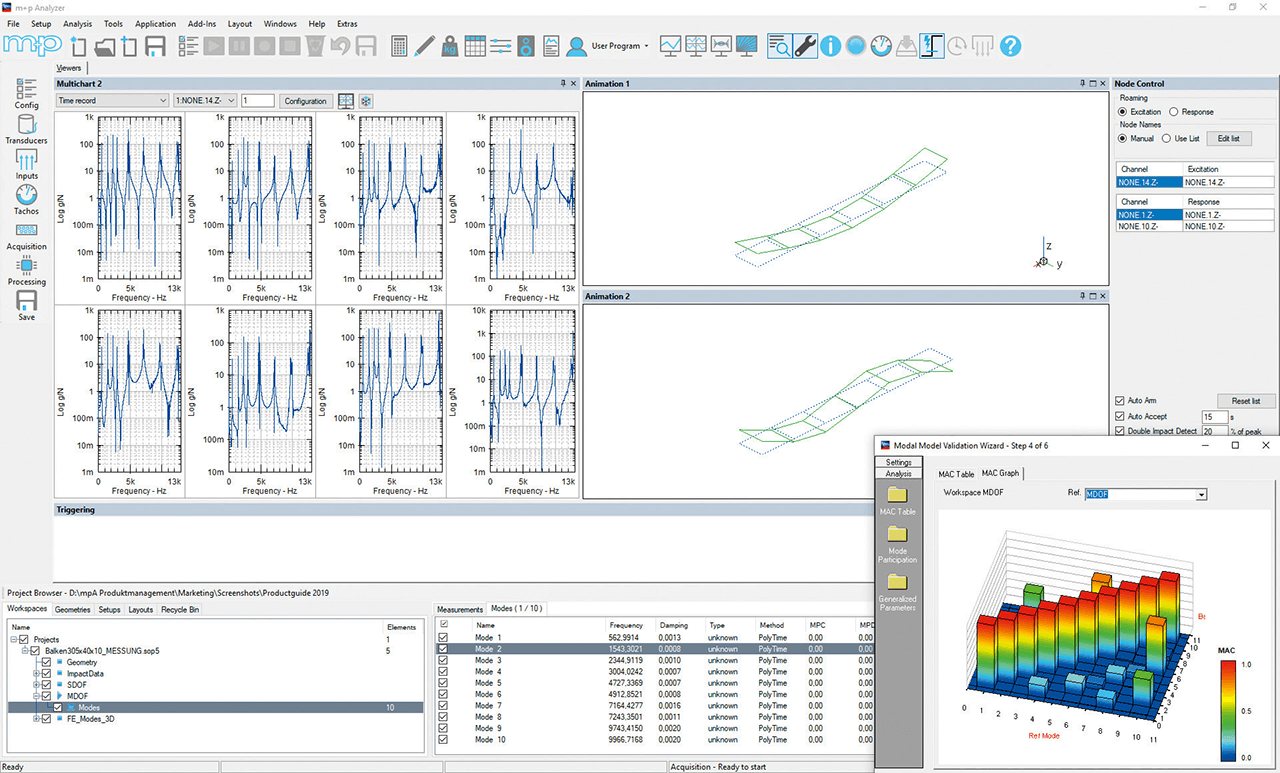
Products
Modal Analysis
The Modal Analysis package is part of m+p Analyzer, m+p international’s dynamic signal analyzer for noise & vibration measurements and analysis. It provides a complete set of tools for observing, analysing and documenting the vibrational behaviour of machines and mechanical structures. Software modules are available for classical and operational modal analysis, shaker measurements (SIMO and MIMO) as well as for ODS, SDOF and MDOF analysis. A modal model validation module is also provided.
Experimental Modal Analysis
The software makes it very simple to create the structure‘s geometry and calculate modal parameters including mode shape animation. The experimental modal data (frequency, damping and mode shape) are obtained by curve fitting a set of FRF (Frequency Response Function) measurements. FRFs can be directly measured or calculated from time records automatically. FRFs and time records can also be imported from other systems. Structural Dynamics Modifications and FE model correlation and updating are further optional tools.
Wizard-Guided Modal Analysis
Wizards take you through a simple series of steps to complete the modal acquisition and analysis process and also make intelligent estimates of all analysis options. So even an inexperienced operator can produce a reliable result whereas the experienced user can easily fine tune his result for the most difficult analysis situations. The Multiple Degree of Freedom (MDOF) wizard, for example, handles the most sophisticated modal analysis tasks, such as detecting repeated or closely spaced modes.
Geometry Creation
Component based geometries for ODS/modal analysis can be created in a simple step-by-step approach. The steps are to define the components, describe them with nodes and draw lines and surfaces. Geometries can also be imported as UNV/UFF files and from most CAD packages via STL format.
Clear Stabilization Diagrams
The Polyreference Least-Squares Complex Frequency domain algorithm (p-LSCF/Polyfreq) yields very clear stabilization diagrams even for high system orders (above 50) in highly damped structures. For the analysis of weakly damped structures, the Polyreference Least-Squares Complex Exponential Plus algorithm (PTD+/Polytime+) is used. The two algorithms considerably improve the interpretability of the stabilization diagrams.
Ground Vibration Testing
In testing space and aircraft structures ground vibration testing is a common method. In addition to conventional modal tests ground vibration tests are used for further inspection of critical modes. Normal Mode Tuning uses several shakers to force the structure to vibrate in one single mode of vibration. By interactive tuning with online displays of mode shape, MIF etc., the shaker excitation frequency and amplitudes are optimized. The Mode Indicator Function (MIF) indicates when the optimal tuning is reached. Finally a stepped sine measurement is performed using the tuned exciter configuration allowing a detailed investigation of that single mode to be completed



